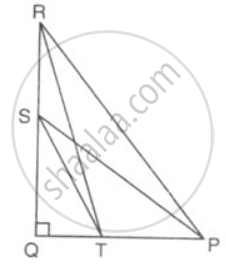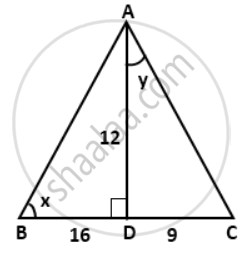Advertisements
Advertisements
प्रश्न
If 12cosecθ = 13, find the value of `(sin^2θ - cos^2θ) /(2sinθ cosθ) xx (1)/tan^2θ`.
उत्तर
12cosecθ = 13
⇒ cosecθ = `(13)/(12)`
⇒ sinθ = `(12)/(13) = "Perpendicular"/"Hypotenuse"`
⇒ Base
= `sqrt(("Hypotenuse")^2 - ("Perpendicular")^2`
= `sqrt((13)^2 - (12)^2`
= `sqrt(169 - 144)`
= `sqrt(25)`
= 5
cosθ = `"Base"/"Hypotenuse" = (5)/(13)`
tanθ= `"Perpendicular"/"Base" = (12)/(5)`
Now, `(sin^2θ - cos^2θ) /(2sinθ cosθ) xx (1)/tan^2θ`
= `((12/13)^2 - (5/13)^2)/(2(12/13)(5/13)) xx (1)/(12/5)^2`
= `(144/169 - 25/169)/(120/169) xx (25)/(144)`
= `(119)/(120) xx (25)/(144)`
= `(595)/(3456)`.
APPEARS IN
संबंधित प्रश्न
In the given figure, ∠Q = 90°, PS is a median om QR from P, and RT divides PQ in the ratio 1 : 2. Find: `("tan" ∠"PSQ")/("tan"∠"PRQ")`
In the given figure, AD is perpendicular to BC. Find: 5 cos x
In the given figure, AD is perpendicular to BC. Find: 5 cos x - 12 sin y + tan x
If 4 sinθ = 3 cosθ, find tan2θ + cot2θ
If 8tanA = 15, find sinA - cosA.
If 3cosθ - 4sinθ = 2cosθ + sinθ, find tanθ.
If 5cosθ = 3, find the value of `(4cosθ - sinθ)/(2cosθ + sinθ)`
If cosecθ = `1(9)/(20)`, show that `(1 - sinθ + cosθ)/(1 + sinθ + cosθ) = (3)/(7)`
If 3 tanθ = 4, prove that `sqrt(secθ - "cosec"θ)/(sqrt(secθ - "cosec"θ)) = (1)/sqrt(7)`.
If tan θ = `"m"/"n"`, show that `"m sin θ - n cos θ"/"m sinθ + n cos θ" = ("m"^2 - "n"^2)/("m"^2 + "n"^2)`
